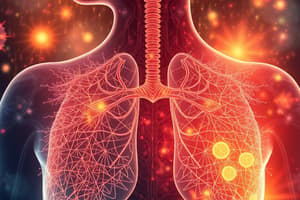Podcast
Questions and Answers
what generate a normal cyclic pattern of respiration?
what generate a normal cyclic pattern of respiration?
the pons and medulla in the brain.
pattern pf respiration is altered by
pattern pf respiration is altered by
(homeostatic) and (adaptive) reflexes.
describe the feedback mechanism if there's an increase of Pco2/or decreased pO2.
describe the feedback mechanism if there's an increase of Pco2/or decreased pO2.
chemoreceptors in carotid body will detect this change>send signal to the respiratory control centre (medulla,pons)>send signal to resp muscle>increased frequency of depth of breathing.
describe the role of DRG (dorsal resp group) during normal quiet inhalation.
describe the role of DRG (dorsal resp group) during normal quiet inhalation.
whats the role of the DRG in normal quite exhalation.
whats the role of the DRG in normal quite exhalation.
describe the role of DRG during forceful inhalation.
describe the role of DRG during forceful inhalation.
the role of VRG during forceful exhalation.
the role of VRG during forceful exhalation.
neurones involved in forceful inhalation/exhalation
neurones involved in forceful inhalation/exhalation
neurones involved in inhalation but not in exhalation
neurones involved in inhalation but not in exhalation
voluntary hyper/hypo ventilation is controlled by
voluntary hyper/hypo ventilation is controlled by
Flashcards
Normal Respiration Pattern
Normal Respiration Pattern
The rhythmic cycle of breathing, regulated by the pons and medulla in the brain.
Factors altering Respiratory Pattern
Factors altering Respiratory Pattern
Homeostatic and adaptive reflexes adjust the breathing pattern.
Increased CO2/Decreased O2 Feedback
Increased CO2/Decreased O2 Feedback
Chemoreceptors detect changes in CO2 or O2 levels. Signal is sent to respiratory centers that increase breathing rate and/or depth.
DRG (Dorsal Respiratory Group) Quiet Inhalation
DRG (Dorsal Respiratory Group) Quiet Inhalation
Signup and view all the flashcards
DRG Quiet Exhalation
DRG Quiet Exhalation
Signup and view all the flashcards
DRG Forceful Inhalation
DRG Forceful Inhalation
Signup and view all the flashcards
VRG (Ventral Respiratory Group) Forceful Exhalation
VRG (Ventral Respiratory Group) Forceful Exhalation
Signup and view all the flashcards
Forceful Inhalation/Exhalation Neurons
Forceful Inhalation/Exhalation Neurons
Signup and view all the flashcards
Quiet Inhalation Neurons (Inactive in Exhalation)
Quiet Inhalation Neurons (Inactive in Exhalation)
Signup and view all the flashcards
Voluntary Breathing Control
Voluntary Breathing Control
Signup and view all the flashcards



